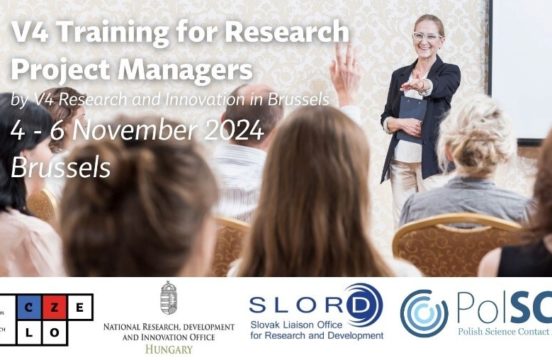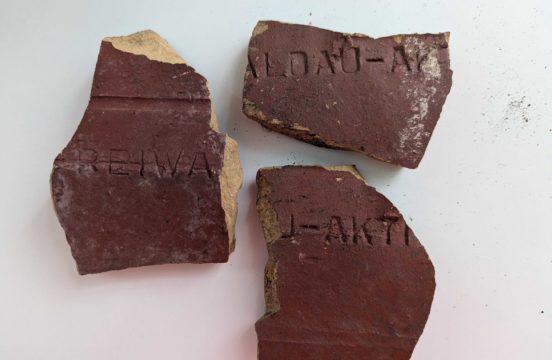At the end of November, the majority of our team met in Brno, at the invitation of the local chapter of the Institute of Ethnology of the Czech Academy of Sciences. Thanks to the Department of Memory Studies’ kind invitation, we presented our research’s preliminary results to its members and the public. Karolina Ćwiek-Rogalska presented the theoretical and methodological framework of the research. Karina Hoření introduced her novel rethinking of the Czech and Slovak borderlands based on data from her ethnographic and archival research. Magdalena Bubík presented several case studies from her research on formerly German Protestant churches in North Bohemia. We discussed our research for over two hours and received valuable feedback. Thank you again for the invitation!
News
Spectral Recycling grant as an example of an effective strategy to promote research
Our manager and facilitator, Angelika Zanki, drawing from her experience in promoting scientific activities, engaged in interactive session with PhD students at the Anthropos Doctoral School. The meeting served as a platform for knowledge-sharing and brainstorming, focusing on effective strategies for scientists to promote themselves and their research. The emphasis was on the dos and don’ts of self-promotion, as well as the exploration of various promotional channels and approaches. Our manager also highlighted examples of successful promotional practices and activities carried out under the Spectral Recycling grant.
Imported (Hi)Stories – an exhibition about post-war settlers in Goleniów
Settlers arriving in the so-called Recovered Territories from other parts of Poland or from abroad after World War II often brought only little with them. What everyone brought, however, was their family (hi)stories. Our partner project “Goleniowske Fotohistorie” project is trying to bring this seemingly forgotten part of history back to light. Light plays a key role in the project, because it works with glass negatives on which there are photographs of the first settlers of post-war Goleniów, a town in West Pomerania. Some of them are classic portraits, while others capture important moments of their everyday life, such as weddings, births of children or first communions. They were photographed by the first post-war city photographer, Marian Dałkiewicz and his wife Zofia.
As Karolina wrote in her blog post, photographs of people whose names we do not know have a ghost-like character and are associated with a lot of questions about the people in them. The “Goleniowske Fotohistorie” project tries not only to preserve the found negatives for future generations, but also seeks to answer these questions. From November 15 to 23, in cooperation with our researchers Karolina and Michal, it organized an exhibition of some of the photographs under the title “Historie przywiezione” [Imported (Hi)Stories]. It presented visitors not only the photographs themselves, but also their authors and partly also the stories of people who have been recognized in the photos over time. In addition, as one of the first ones it showed the town’s post-war history from the perspective of the settlers. An important aspect was the map on which visitors could mark where their family came from to Goleniów after World War II.
As part of the exhibition’s opening, visitors had the opportunity to have their own photos taken using the technique that was still used in the post-war period. The accompanying program included several presentations about the project itself or portrait photography as such. People from the photographs also had the opportunity to speak, telling how the pictures were created and what they remember from that time. In the last part of the program, our researchers Karolina and Michal presented their research on the history of the so-called Recovered Territories based on the German objects that they found in Goleniów during their fieldwork.
Interactive walk with Karina Hoření in Liberec
At the beginning of November, Karina Hoření was invited by Dr. Sally Anderson Boström to lecture at the Technical University in Liberec. Karina took advantage of the faculty’s location in Liberec’s historic district to guide the students of the Department of English through the places she is researching. She illustrated her main findings with the examples of the villa of the Liberec factory owner Theodor Liebieg that was turned to a kindergarten after the war, the villa of Goltz family where later the so-called Revolutionary Guards (Revoluční Gardy), and the former Staatsoberrealschule – currently Husova Grammar School. We are grateful for the opportunity to present the results of our research right in its center and thank the students for their interest and stimulating debate.



photos: Sally Anderson Boström
New episode of the Czechostacja podcast. Karolina Ćwiek-Rogalska on Czech sense of humor
Jára Cimrman, a fictional genius created by the satirists from the Jára Cimrman Theatre, has been a source of humor for Czechs for almost fifty years. Despite being a fictional character, Czechs have embraced Cimrman as almost a real being, laughing at the absurdity of his life and achievements while also treating him with a certain level of respect. The latest podcast of the Czechostacja explores the phenomenon of Cimrman, delving into his fictitious life and the origins of his character, initially created to satirize national figures. The podcast also discusses how Czech humor serves as an escape from challenging realities, highlighting the cultural significance of the Cimrman concept.
Link to the podcast you can find here (YouTube).
Angelika Zanki at the training in Brussels
Recently, our project manager and facilitator, Angelika Zanki, participated in a project management training in Brussels, focusing on fundraising, budgeting, and reporting. The training emphasized international projects within the EU framework programs, similar to our own.
The 3-day training, held from November 4-6, 2024, featured presentations by representatives from the European Commission, experts from liaison offices, and academic centers. Participants also had the chance to network and exchange experiences. Angelika found the opportunity to meet key Polish stakeholders in Brussels particularly valuable, including Magdalena Kula, Research Attaché at the Permanent Representation of Poland, and Waldemar Dubaniowski, director of the NCBR Brussels office. Additionally, there was a session on the PM2 methodology, conducted by Marc Berghmans.

Angelika was thrilled to attend this event. As she regularly participates in various trainings to improve her competencies for the ERC StG grant, we encourage you to frequently visit our website and Facebook profile, which she manages.
The “V4 Training” was co-organized by the Polish Science Contact Agency “PolSCA,” the Czech Liaison Office for Education and Research in Brussels (CZELO), the National Office for Research, Development and Innovation in Hungary (NRDIO), and the Slovak Liaison Office for Research and Development in Brussels (SLORD).

Summer Fieldwork Insights of the Spectral Recycling Team
Our team has been dedicated to conducting extensive field research in post-displacement regions over the past few months. Each team member has completed multiple research trips in order to gain a deeper understanding of the challenges and opportunities within these areas. Following each trip, we come together to collectively review, analyze, and share the insights gathered, which has been the primary focus of our most recent seminars.
The team has been actively engaged in fieldwork, delving into the complexities of displacement, memory, and the interwoven histories of people and places. Karin’s presence in Nové Město pod Smrkem allowed her to experience the lives of those living among formerly German belongings, tracing the fragmented histories of objects and uncovering mysteries that seem to lead nowhere – such as the mystery surrounding an old window or door in her photograph below.

Similarly, Michal’s exploration in Voerde, Germany, focused on the memories of German people displaced from Handlová, and the stories of those who returned to visit this place years later. His work shed light on how individuals perceive the region today, providing valuable insights into the enduring impact of displacement.

Magdalena’s attendance at the 25th anniversary of the Evangelical-Augsburg parish in Piła provided an opportunity to search for connections to the German Lutheran legacy in the region, further enriching our understanding of the enduring ties between communities.

Meanwhile, Karolina’s work not only involved gathering the narratives of resettlers but also using them as the foundation for a temporary exhibition at the Wałcz Land Museum, amplifying the voices of those whose stories might otherwise go unheard.

The team’s fieldwork continues to to bring unexpected stories to light, deepening our understanding of the intertwined relationships between places, objects, and people.
New episode of the Radio Naukowe podcast featuring Karolina Ćwiek-Rogalska
We want to congratulate Karolina on her recent book, “Ziemie. Historie odzyskiwania i utraty”, published by the Wydawnictwo RN in September. It is a book that zooms the Polish readership to the history of the Polish “Recovered Territories” and how it can be told. The publication is not the result of a grant, but it will certainly be a great source of information for readers interested in the history of the so-called Recovered Territories.
At the premiere, a special video episode of the podcast Radio Naukowe was broadcasted. We invite you to watch it, as some German ghosts are also mentioned!
You can watch mentioned episode here.
Broadcast – “Klub Trójki: Audiodokument”
How do contemporary inhabitants of cities such as Wrocław treat the material remains of the German presence? This was one of the questions in Magdalena Skawińska’s audio nonfiction “Historia ze śmietnika” (“History from the garbage can”), and our PI, Karolina, was a guest at the audition hosted by Anna Dudzińska at the Polish Radio “Trójka”, focused on this issue precisely. Together, they discussed how the formerly German objects in Poland play various roles in today’s society. They also reflected on how these objects also hold personal and sentimental value for individuals and families in the “Recovered Territories” . The discussion shed light on the significance of these everyday items and the stories they hold, providing a deeper understanding of their impact on our lives.
More information you can find here.
New article. A Brave New World Out of the Same Old Pieces: Property Confiscation and Distribution in Postwar Czechoslovakia
In the latest issue of the Nationalities Papers you can find an article written by Karina Hoření titled “A Brave New World Out of the Same Old Pieces: Property Confiscation and Distribution in Postwar Czechoslovakia”.
The article discusses the confiscation of property from German-speaking inhabitants of Czechoslovakia after World War II and its redistribution to new settlers in the Czech borderlands. It highlights how the national revolution, which resulted in the expulsion of German-speaking inhabitants from Central Europe, enabled a social revolution. The author uses the example of Liberec in northern Bohemia to illustrate how the Czech administration applied the Czech–German conflict to the ethnically diverse postwar society, resulting in discrimination against non-Czech minorities regarding property redistribution. The article also examines the shaping of postwar Czechoslovak society, emphasizing the material demands of workers and collectives, while individuals sought to attain a middle-class lifestyle through participation in property distribution. Overall, the article sheds light on the complexities of postwar society in Czechoslovakia and the impact of property redistribution on different ethnic groups.
Link to the article you can find here.










